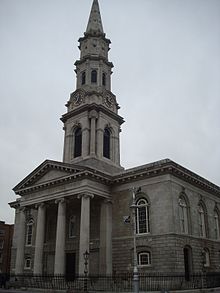St. George's Church, Dublin
| St. George's Church | |
|---|---|
 |
|
| Location | Dublin |
| Country | Ireland |
| History | |
| Founded | 1802 |
| Dedication | St. George |
| Architecture | |
| Architect(s) | Francis Johnston |
| Construction cost | £90,000 |
| Closed | 1990 |
| Specifications | |
| Length | (exterior) 84 feet (25.6 m) |
| Width | (exterior) 92 feet (28.0 m) |
| Spire height | 200 feet (61.0 m) |
| Administration | |
| Parish | Parish of St. George |
St. George's Church is a former parish church in Dublin, Ireland, designed by Francis Johnston, which is considered to be one of his finest works. It is located at Hardwicke Place, just north of the city centre. The elegant spire, 200 feet (61.0 m) high, became a landmark of the north inner city.
Construction of the "New St. George's church, Drumcondra", at the end of Temple Street, Dublin (the street so named after the church) commenced in 1802 by the Church of Ireland for the parish of St. George, which had been established in 1793. There had been an "Old St. George's church, Drumcondra", in nearby Hill Street erected by Sir John Eccles. The Eccles family were patrons of the "new church". Another "Drumcondra Church" is the St. John Church, in Church Street, Dublin.
The original site acquired for the new church was on Whitworth Road, but then the present site was selected, which at the time was open fields. A temporary chapel was built on the Whitworth Road site and the churchyard was retained when St. George's was completed - this site was later taken over by the Whitworth Hospital (later named Drumcondra Hospital).
Twenty-two years after the church was built, problems developed when the wide roof began to splay further than it should, due to the strain of the wide-span timber trusses. Civil engineer Robert Mallet, whose father ran an iron foundry in Dublin, created cast-iron trusses to haul the church back into shape.
In the 1980s scaffolding had to be erected around the spire because the Portland stone was cracking due to expansion of the iron cramps that held it in place. The Church of Ireland, having tried in vain to raise funds for the restoration of the church, sold the building in 1991 to an actor, Mr Sean Simon, who had plans to turn it into a theatre.
After its deconsecration, the bells (which Leopold Bloom heard ringing in Ulysses) were removed to Taney Parish church in Dundrum, while the ornate pulpit was carved up to decorate Thomas Read's pub in Parliament Street.
The church in Temple Street then became the Temple Theatre, then a night-club, but further attempts were made to raise public funds for its restoration; first, in 1991, to celebrate Dublin's role as European City of Culture, and later from the Millennium Committee.
...
Wikipedia
